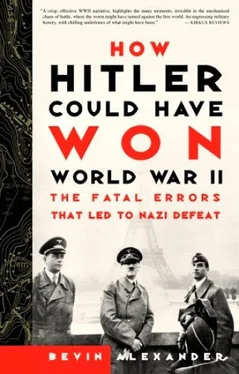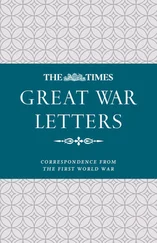Manstein and Guderian were certain the Meuse could be breached quickly with only panzer divisions and Luftwaffe bombers, and they believed speed would guarantee that the French would not have time to bring up enough troops to stop them. Speed also would ensure that few enemy units would be in place to block the panzers as they drove right across France to the Channel.
In November 1939 Hitler directed that a new panzer corps of three divisions, the 19th under Guderian, be attached to Army Group A with Sedan as its target. Since the OKH had not told Hitler of Manstein’s plan, he probably made the decision because he saw that Sedan was the easiest place to cross the Meuse. In any event, OKH ignored Manstein’s bolder strategy.
At the end of November, still without changing the northern focus of the offensive, OKH did move up behind Army Group A’s assembly area the 14th Corps of four motorized infantry divisions. These divisions had no tanks, but were almost as fast as the panzer divisions and could be of invaluable help in securing the flanks if the panzers were able to break out to the west.
On January 10, 1940, a staff officer of a German airborne division made a forced landing in Belgium. When captured, he was carrying orders he was only partially able to burn which gave away a large part of the German operations plan ( Fall Gelb or “Case Yellow”). Many leaders on the Allied side concluded afterward that this was the event that caused the German high command to change its strategy. But it was not so. On January 25, at a commander-in-chief’s conference with all army group and army commanders, the plan remained the same. On the Allied side, the commanders were not certain whether the captured orders were authentic or a plant. They also did not change their plans.
“Quite unconsciously,” Manstein observed, “the German and Allied high commands had agreed that it was safer to attack each other head-on in northern Belgium than to become involved in a venturesome operation—on the German side by accepting the plan of Army Group A, on the Allied side by avoiding a conclusive battle in Belgium in order to deal a punishing blow to the southern flank of the German offensive.”
Manstein’s barrage of requests to change its strategy had become a nuisance to OKH, and on January 27, 1940, saying Manstein was due for promotion, it appointed him commander of 38th Corps, an infantry outfit with only a walk-on role in the upcoming campaign. The OKH hoped Manstein would conveniently disappear, but he used the appointment to make a decisive change in German strategy.
On February 17, Manstein was summoned to Berlin to report to Hitler for an interview and luncheon, along with other newly appointed corps commanders. Lieutenant Colonel Rudolf Schmundt, chief adjutant to Hitler, had been apprised of Manstein’s proposals, and he arranged for Manstein to talk privately with Hitler after the meal.
“I found him surprisingly quick to grasp the points which our army group had been advocating for many months past, and he entirely agreed with what I had to say,” Manstein wrote later.
The next day, in response to Hitler’s orders, OKH issued new directives that reflected Manstein’s proposals. Manstein’s idea became known in the German army as the Sichelschnitt, or “sickle-cut plan,” an apt description signifying that a strong armored thrust would cut through the weak portion of the Allied defenses like a harvester’s sickle cut through soft stalks of grass or grain.
OKH set up a new “panzer group” of five armored and four motorized divisions under General Ewald von Kleist containing Guderian’s 19th Corps, Hans Reinhardt’s 41st Corps, and Gustav von Wietersheim’s 14th Motorized Corps. These were to be der Sturmbock (battering ram) to breach the Meuse around Sedan. Also allocated was the 15th Corps under Hermann Hoth, whose two panzer divisions would cross the Meuse farther north at Dinant and shield Kleist’s main effort on that flank. OKH allocated 2nd Army to help protect Army Group A’s southern flank. OKH thus transferred the main weight to the southern wing.
At the same time Bock’s Army Group B remained strong enough, with three armies, to attack into northern Belgium and Holland. Bock had the remaining three panzer divisions—two in the 16th Corps under Erich Hoepner to lead his assault, and one (the 9th under Alfred Hubicki) detailed for the Holland operation.
It was a radical and astonishing transformation and the best military decision Adolf Hitler ever made. By shifting the Schwerpunkt to the Ardennes Hitler set up the conditions for an overwhelming victory that could transform the world.
Meanwhile the situation in the Allied camp was changing dramatically. French Premier Edouard Daladier could not summon the courage to dismiss General Maurice Gamelin, the French commander in chief, who was proving to be incompetent.
The French parliament was angry with Daladier because the Allies had done nothing to help Finland, while the Germans were massing on the frontiers of the Low Countries. On March 18, 1940, he lost a vote of confidence in the Chamber of Deputies. Paul Reynaud formed a new government, but had to accept Daladier as minister of defense, and Daladier held on to Gamelin.
This did not sit well with Reynaud, and he resigned, but the president of the republic, Albert Lebrun, induced him to run the government on a provisional basis. Thus France at the moment of its highest need found itself saddled with a weak and indecisive government.
A few weeks later in Britain, Prime Minister Neville Chamberlain could not present a convincing explanation for the Norwegian fiasco to the House of Commons, and his support, already weak because of his appeasement of Hitler, evaporated. On the evening of May 9, 1940, Labour Party leaders Arthur Greenwood and Clement Attlee refused to form a unified government with the Conservatives so long as Chamberlain remained chief of the Conservative Party. This forced his resignation.
The next day, the very day the Germans attacked in the west, Winston Churchill—the strongest and most eloquent voice in England against Hitler—seized the rudder of a unity government. Chamberlain belonged to it as Lord President (a job with little power), Lord Halifax led the Foreign Office, and Anthony Eden switched from the Colonial Office to the War Ministry. Attlee became Lord Privy Seal and deputy premier, while Greenwood became minister without portfolio. Churchill demanded for himself the newly formed Ministry of Defense. From then on, he could make agreements with the chiefs of staff over the head of the minister of war.
The German forces arrayed on the frontiers of Holland, Belgium, and Luxembourg on May 10, 1940, presented a tremendously different picture from armies that had gone before. Ordinary infantry divisions were noticeably absent. These traditional orthodox mainstays that marched to battle and fought on foot had been preempted. In the campaign about to erupt, they were too slow to have decisive jobs. The real agents of victory were in part a few airborne troops attached to the northern group, but mainly the new German Schnellentruppen, “fast troops”—the panzer and motorized divisions.
The campaign in the west was going to be decided by only part of these fast troops—seven panzer divisions in Army Group A—a force representing only 8 percent of total German strength. The three panzer divisions of Army Group B were to play important roles. But the actual disruption of the Allied position took place in the first phase of the campaign, and the seven armored divisions in Army Group A were the instruments.
The Luftwaffe had an important task in assisting the panzers. Messerschmitt 109 Bf fighters were to destroy enemy aircraft, and the bombers, principally Stukas, were to give ground support on the battle line.
Читать дальше


![Джонатан Димблби - Barbarossa - How Hitler Lost the War [calibre]](/books/385421/dzhonatan-dimblbi-barbarossa-how-hitler-lost-the-w-thumb.webp)









